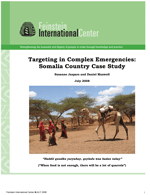Can community-based approaches to the targeting of humanitarian assistance in complex emergencies improve participation and reduce targeting error? Although the literature suggests that community-based targeting works best in slow-onset emergencies with no conflict or displacement, participatory approaches to targeting assistance have been attempted in complex emergencies.
This study examined community participation throughout the food aid program cycle to understand the role of recipient communities in the targeting of food assistance under the conflict conditions in Somalia, a country that has not had a central government since the fall of the President Siad Barre in 1991. Security considerations, limited staff numbers and other constraints have long meant that the actual oversight of what happens with food aid must be left in the hands of local leaders at the village or camp level. The study found big differences in the accountability and legitimacy of local leadership in different locations, from clan elders and religious leaders in some locations, to “gate keepers” who control information, access, and resources in other locations, especially in IDP camps. Though “committees” of “local leaders” exist in both situations, the degree to which leaders actually represent the “community” differs enormously. The practice of redistribution of food assistance limits the number of people in any recipient community who are excluded from food assistance, but also ends up ensuring that no one receives very much. Most communities hold strong views that external assistance in the form of food should be shared equally within communities. But much of the process of food aid targeting remains opaque to recipients. They are often not aware of their entitlements or the process of determining who is entitled. The report makes various suggestions for improving participation in targeting, and improving targeting generally.
This research is one case in a study commissioned by the World Food Programme to investigate the participation of recipient communities in the targeting and management of humanitarian assistance in complex emergencies.

